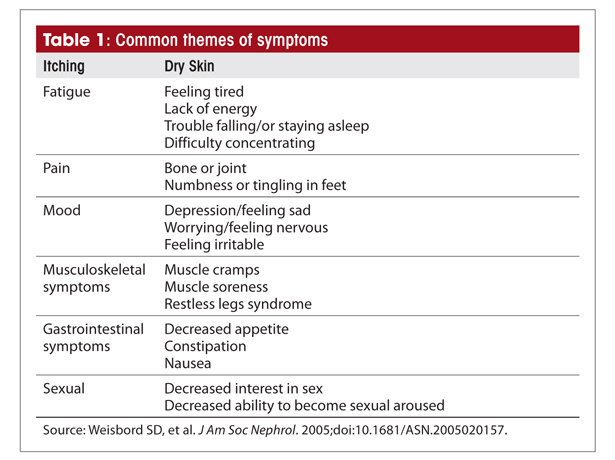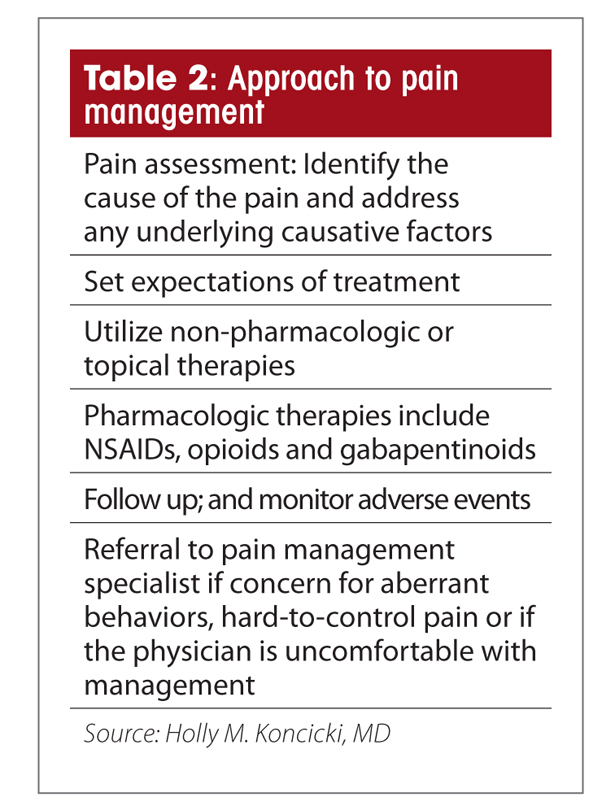How to manage symptoms in patients with ESRD
A common challenge nephrologists encounter is deciding when to start patients on dialysis. Clear indications exist, such as life-threatening metabolic abnormalities, refractory volume overload or uremic complications, though sometimes dialysis is initiated earlier due to uremic symptoms.1 Strong evidence is lacking to show the efficacy of dialysis in decreasing uremic symptoms. Despite being initiated on dialysis, many patients with ESRD continue to experience a large symptom burden.
In studies assessing symptom burden, patients who receive dialysis experience nine symptoms during the course of a week.2 The presence of these symptoms is associated with decreased health-related quality of life (HRQoL) and depression.1,2 Initiation of dialysis has a variable effect on HRQoL scores and symptom metrics. Therefore, it is essential that we continue to inquire, evaluate and address these symptoms (see Table 1).

Several themes exist regarding the evaluation and treatment of symptoms in patients on dialysis. We have limited evidence for symptom management. Most treatments are based on small case control studies; most approaches for treatment are inferred from studies in the general population in which drug metabolism may differ from that in patients on dialysis; and these symptoms rarely occur alone and are often clustered with others. Lastly, many of these symptoms are associated with poor outcomes, including decreased HRQoL, and increased morbidity or mortality. The following is a discussion of management strategies for several common symptoms.
Pain
Pain is one of the most common symptoms experienced by patients receiving dialysis, with estimates of at least 50% reporting chronic pain.3 Prevalence is comparable regardless of modality, and correlation with dialysis vintage exists. Pain has been associated with negative effects on HRQoL, higher rates of depression and insomnia, as well as increased numbers of shortened or missed dialysis treatments. Therefore, it is important to screen for pain and treat if present.
Non-pharmacologic therapies have been shown to have efficacy and little, if any, negative effects. These include cognitive behavior therapy (CBT), exercise, massage, music therapy, acupuncture and cold/heat applications.4 Topical agents, including lidocaine or NSAID patches, also can be used if pain is localized.
A recent excellent review is available regarding the pharmacologic management of pain in this population and should be referred to for a thorough discussion regarding approach to therapy.5
The use of NSAIDs has recently come under debate in regard to both the safety and efficacy of use in patients receiving dialysis. In this population, concern exists regarding volume retention and worsening of hypertension, though evidence is limited.6 One study has shown an increased risk of stroke by 30% in patients receiving dialysis, who were using NSAIDs.7 Another recently published study showed an increased mortality risk in this population.8 The use of opioids and gabapentinoids has been associated with increased morbidity and mortality for patients receiving dialysis.9-11 This association has not been shown to be causative and may be related to selection bias; sicker patients may experience more pain related to their overall clinical condition and therefore have increased mortality at baseline.
A full discussion regarding approach to treatment is outside the scope of this paper, but briefly summarized in Table 2.

Pruritus
Up to 84% of patients receiving hemodialysis report daily pruritus, and 42% describe it to be moderate to severe in intensity.12,13 Pruritus is associated with other symptoms, including poor sleep, decreased HRQoL and depression.1,12 Effective treatment that reduces the severity of pruritus by 20%, has shown benefit in improving HRQoL.14 After infectious, non-uremic systemic or primary dermatologic conditions have been addressed, treatment for uremic pruritus involves an approach of optimizing dialysis adequacy, controlling calcium and phosphorus levels, and hydrating the skin with emollients.12 Non-pharmacologic therapy includes UVB phototherapy and acupuncture. Should symptoms persist, systemic treatments can be attempted. Although antihistamines, such as diphenhydramine, are often administered, it is not recommended as recent studies have shown that uremic pruritus is not transmitted via histaminergic pathways. Gabapentinoids are not FDA approved for pruritus but have been shown to be effective as compared to placebo. Recommended starting doses are low with slow titration — for example, starting gabapentin 100 mg three times weekly or pregabalin 25 mg nightly.12
Restless leg syndrome
Restless leg syndrome (RLS), an uncontrollable urge to move one’s legs often at night or rest, is estimated to affect 25% of patients receiving dialysis.15 RLS is also associated with premature termination of dialysis, cardiovascular mortality, anxiety, daytime sleepiness, sexual dysfunction, decreased HRQoL and increased morbidity.1,12 Pathogenesis may be genetic, related to cerebral iron stores, or due to dopamine or glutamate imbalance12, and a correlation with lower hemoglobin, low transferrin saturation and poor erythropoietin stimulating agent responsiveness has been shown.
Treatment is largely pharmacologic, with medications targeting either the dopamine or serotonin pathways. Dopamine receptor antagonists, such as ropinirole, pramipexole and rotigotine, have been shown to be effective, though long-term use may worsen symptoms.12 Gabapentinoids, specifically gabapentin and pregabalin, inhibit glutamate release and have been shown to be effective when compared to placebo or levodopa, though large randomized control studies are lacking.12
Other therapies including use of IV iron or opioids have had inconsistent results. Non-pharmacologic therapy, including intradialytic exercise, and daily dialysis sessions have shown benefit.12
Depression
Nearly 20% of patients on dialysis have major depression and 40% have a depressed affect.16 A two-question screening tool, the patient health questionnaire (PHQ2), can identify those patients who may benefit from further evaluation. This tool asks, “Over the last 2 weeks, how often have you been bothered by 1) feeling down, depressed or hopeless or 2) had little interest or pleasure in doing things.”
Currently, no standard algorithm exists to treat depression in patients receiving dialysis. Non-pharmacologic management including CBT has been shown to be effective in reducing depression scores, improving HRQoL and improved compliance with dialysis.17 Evidence also exists for use of serotonin reuptake inhibitors (SSRIs) as well as tricyclic antidepressants.The European Best Renal Practice recommends treatment with an SSRI for 8 to 12 weeks followed by evaluation of efficacy.18
Sleep disorders
Sleep disturbances are common in patients receiving dialysis. They may experience less total sleep and rapid eye movement (REM) sleep time, higher brief arousal index, higher respiratory disturbance index and increased number of sleep apnea episodes.1 Less than 20% of patients report an improvement in sleep symptoms after the initiation of dialysis.1 In the Dialysis Outcomes Practice Patterns Study, 49% of patients had self-reported sleep disorders which correlated with comorbid conditions, symptoms including pain, depression and pruritus, and with increased mortality.12,19
In patients with ESRD, evaluation and treatment of sleep disturbance should include three categories. The first includes non-kidney disease factors, such as sleep apnea, nocturia, delirium, symptoms and medications. Consequences of kidney disease should be evaluated, with some studies suggesting elevations in blood urea nitrogen and phosphate contribute to sleep disorders. Additionally, there is a loss of the evening surge of melatonin in kidney disease which can disrupt the sleep cycle.20 Lastly, the dialysis procedure itself may affect sleepiness, which is hypothesized to be related to treatment- induced elevations in core body temperature.12
To begin an approach to treatment, counseling on basic sleep hygiene should occur while concurrently addressing any identified contributing factors.12 CBT has been shown to be effective in patients who receive dialysis and can also be used. Alteration of the dialysis prescription can also be attempted. For example, cooling the dialysate has been shown to decrease sleep latency and showed a trend toward longer sleep time. Short daily hemodialysis has been shown to improve sleep-related factors, but not quantity of sleep when compared to short intermittent hemodialysis. Nocturnal dialysis has been shown to decrease sleep apnea.12

Source: Rowena Taylor, MA
Data on pharmacologic treatment of insomnia are limited in this population, though a small study has shown efficacy of zalepon, which is a member of the non-benzodiazepine class of medications.12 As recommended for most medications in ESRD, starting low doses and titrating cautiously is recommended. Melatonin also has been shown to have short-term benefit, although effects dissipate with chronic use.12
Fatigue
Studies have estimated that between 60% to 97% of patients who receive dialysis report fatigue.21 This symptom is likely multifactorial, only in part related to the sleep disturbances previously discussed. Most attention has been given to post-dialysis fatigue but rated of higher importance by patients is “total fatigue” which encompasses the consequences of fatigue on one’s self esteem, personal relationships and life satisfaction.22 As there are limited data regarding treatments for fatigue, research goals have been suggested to evaluate treatment of fatigue, including standardized check lists for medical workup, and studies regarding exercise, CBT and possible use of psychostimulants.21
Cramps
Muscle cramps are estimated to affect upward of 78% of patients receiving hemodialysis and are one of the most common reasons for premature termination of dialysis treatments.23 Cramps are likely related to alterations in the physiology of muscle cells during dialysis (osmotic shifts and decreased oxygen delivery during vasoconstriction as a result of hypotension) or related to nutritional deficiencies.21,23 Evidence on treatment is limited. Although quinine had been used in the past, a black box warning of life-threatening hematologic effects, and the risk of QT prolongation, has taken it off the physician’s list for treating cramps. Alteration of the dialysis prescription by decreasing or stopping ultrafiltration or administrating saline can be used, but may have other unexpected effects such as hypervolemia. Some studies suggest that foods with strong tastes, such as pickles, mustard, vinegar or ginger, can stimulate a neural reflex leading to muscle relaxation, though these foods have not been specifically studied in the dialysis population.21
Supplements such as carnitine, vitamins and creatine have been shown to be effective in small studies.23 Carnitine, though with some inconsistent efficacy, has been studied at doses ranging from 2,100 mg per week to 14,000 mg per week. Vitamin E 400 IU has been shown to be more effective than placebo. A combination of vitamin E and vitamin C (250 mg) has shown a reduction in cramps 97% of the time, which was significantly higher than placebo or with either vitamin alone. Carnitine at 12 mg per session was shown to be effective in reducing cramps in a 10-person single center study.23
Conclusions
Although symptom assessment tools exist, there is no standardized approach for evaluation and treatment of symptoms in the ESRD population. Given the lack of strong evidence regarding treatment of these symptoms, nephrologists and other providers need to determine how to best approach these patients.
Clinicians should discuss with the patient and family the symptoms the patient has, quality of life and the expected risks and benefits of treatment. Setting expectations regarding outcomes is also helpful. Symptoms may not disappear, but the goal should be to reduce severity to a degree that it will not interfere with the patient’s quality of life. Starting with non-pharmacologic therapy or using these in conjunction with pharmacologic therapies is recommended. Referral to subspecialist providers, such as palliative care, can be considered in patients who have hard-to-control symptoms.
- For more information:
- Holly M. Koncicki, MD, is an assistant professor of medicine in the nephrology division of the Mount Sinai Hospital in New York.
- References:
- 1. Cabrera VJ, et al. Clin J Am Soc Nephrol. 2017;doi:10.2215/CJN.01650216.
- 2. Weisbord SD, et al. J Am Soc Nephrol. 2005;doi:10.1681/ASN.2005020157.
- 3. Davison SN. Am J Kidney Dis 2003;42(6):1239-1247.
- 4. Coluzzi F. Drugs. 2018;doi:10.1007/s40265-018-0980-9.
- 5. Davison SN. Clin J Am Soc Nephrol. 2019;doi:10.2215/CJN.05180418.
- 6. Aljadhey H, et al. BMC Cardiovasc Disord. 2012;doi:10.1186/1471-2261-12-93.
- 7. Hsu CC, et al. Kidney Int Rep. 2017;doi:10.1016/j.ekir.2017.01.004.
- 8. Lai KM, et al. Clin Epidemiol.2019;doi:10.2147/CLEP.S204322.
- 9. Ishida JH, et al. J Am Soc Nephrol. 2018;doi:10.1681/ASN.2018010096.
- 10. Ishida JH, et al. Clin J Am Soc Nephrol. 2018;doi:10.2215/CJN.09910917.
- 11. Kimmel PL, et al. J Am Soc Nephrol. 2017;doi:10.1681/ASN.2017010098.
- 12. Scherer JS, et al. Am J Kidney Dis. 2017;doi:10.1053/j.ajkd.2016.07.031.
- 13. Pisoni RL, et al. Nephrol Dial Transplant. 2006;doi:10.1093/ndt/gfl461.
- 14. Mathur VS, et al. Clin J Am Soc Nephrol. 2010;doi:10.2215/CJN.00100110.
- 15. Novak M, et al. Sem Nephrol. 2015;doi:10.1016/j.semnephrol.2015.06.006.
- 16. Cukor D, et al. Nat Clin Pract Nephrol. 2006;doi:10.1038/ncpneph0359.
- 17. Cukor D, et al. J Am Soc Nephrol. 2014;doi:10.1681/ASN.2012111134.
- 18. Nagler EV, et al. Nephrol Dial Transplant. 2012; doi: 10.1093/ndt/gfs295.
- 19. Elder SJ, et al. Nephrol Dial Transplant. 2008;doi:10.1093/ndt/gfm630.
- 20. Koch BC, et al. Nat Rev Nephrol. 2009;doi:10.1038/nrneph.2009.88.
- 21. Flythe J, et al. Clin J Am Soc Nephrol. 2019;doi:10.2215/CJN.07670618.
- 22. Jacobson J, et al. Am J Kidney Dis. 2019;doi:10.1053/j.ajkd.2019.01.034.
- 23. Moledina DG, et al. Sem Dialysis. 2015;doi:10.1111/sdi.12378.
Disclosure: Koncicki reports no relevant financial disclosures.
